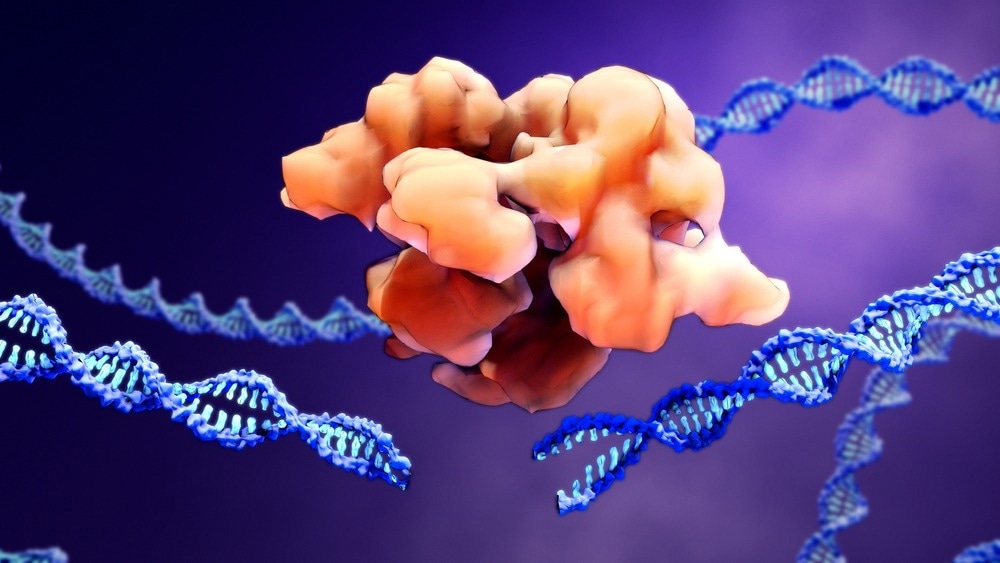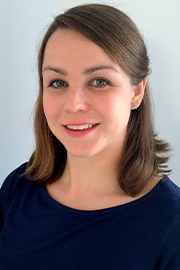In this interview conducted at SLAS EU 2023 in Brussels, Belgium, we spoke to Ulrike Künzel, Associate Director in the Functional Genomics department at AstraZeneca, about the application of arrayed CRISPR screening for target identification and more.
Please could you introduce yourself and tell us what inspired your career in functional genomics?
My name is Ulrike Künzel, and I am an Associate Director in the Functional Genomics department at AstraZeneca. I work on establishing CRISPR screens with high-content imaging endpoints for various diseases, such as kidney disease and oncology, to identify and validate targets for drug discovery.
I have always been interested in understanding more about molecular and cellular mechanisms that underlie disease and how we can use these to make new therapeutics. This is why I studied biochemistry and did a Ph.D. in cell biology.
My Ph.D. inspired me to go into functional genomics as it involved a proteomic screen to find new interaction partners and subsequent screen validation using a small interfering RNA and CRISPR.
CRISPR was a new editing technology at the time that allowed me to make a gene knockout of any gene in any cell type. This was revolutionary and inspired me to investigate CRISPR as a tool for biomedical research, which eventually brought me to my role at AstraZeneca.
What is functional genomics, and how have CRISPR technologies transformed this field?
Functional genomics studies the link between genes and the biology of disease. One tool to achieve this is genetic screening, and CRISPR technology has advanced this field because it enables us to precisely knockout genes.

Image Credit: Design_Cells/Shutterstock.com
With CRISPR/Cas9 gene editing, we can permanently and with precision delete a single gene from the cell. We can do that at scale and systematically delete every possible gene in the genome, which is approximately 20,000 genes, and measure the loss of each gene in a phenotypic assay using, for example, imaging or flow cytometry. In that way, we can study how the loss of a gene affects disease-relevant pathways. CRISPR screening has, therefore, accelerated our understanding of disease mechanisms and gene function and helped us to identify potential new therapeutic targets.
CRISPR has advanced the genetic screening field. Before CRISPR, we performed genetic screens using RNA interference. RNAi is a good tool but has disadvantages such as a lack of precision, many off-target effects, and permanently reducing gene expression.
At SLAS EU 2023, you gave a talk entitled “The application of arrayed CRISPR screening for target identification in primary cells.” Please can you give an overview of what you discussed in this talk?
I present an overview of our arrayed CRISPR screening platform and how we use it for the identification of new targets. I focus on two examples using primary cells.
We aim to perform CRISPR screens in disease-relevant and translatable cell models. These often involve primary cells, which come with challenges that we have to overcome. For example, we are limited in the number of cells that can be used. We need to find ways to deliver the CRISPR agents into the cells that are often difficult to transfect. We also often have complex phenotypic endpoints that we wish to analyze.
I present strategies to address these limitations, for example, by using artificial intelligence (AI). Furthermore, I discuss how our arrayed CRISPR screening platform is adaptable to various diseases: We can tailor our gene editing workflows and phenotypic endpoints to the required disease model and can, therefore, deliver CRISPR screens for a variety of biological questions.
This year, SLAS EU has four tracks, including “Biology Unveiled” and “Shaping the Future of Therapeutics.” How is arrayed CRISPR screening applicable to both tracks?
Arrayed CRISPR screening is a powerful tool to unveil the link between a gene and a biological pathway or disease. In arrayed CRISPR screening, one gene is deleted at a time in one well. We can couple this with phenotypic endpoints, such as imaging or flow cytometry, to better understand the phenotypes a gene knockout generates and how that links to disease.
The CRISPR technology can also be applied as a medicine and could be a future therapeutic. CRISPR medicines or therapeutic gene editing aim to cure genetic diseases by permanently deleting or correcting disease-causing mutations. This comes with huge challenges but has enormous therapeutic potential.
How have recent methodological advances in CRISPR screening impacted the fields of oncology?
CRISPR screening is a very young field, with the technology evolving only ten years ago. Over this time, there have been many advances in the technology. For example, there has been improvement in guide RNA design which has inspired smaller libraries for pooled CRISPR screening.
There have also been new CRISPR-based technologies, such as CRISPRi (CRISPR interference), CRISPRa (CRISPR activation), and even CRISPR base editors to make specific point mutations in the genome. These technologies work without creating double-strand breaks, making them particularly applicable to oncology.
Arrayed CRISPR Screening for Revolutionizing Target Discovery
Other advances consider more complex cell models, such as organoids and primary cells, which require the development of CRISPR reagent delivery, like electroporation and lipid nanoparticles.
CRISPR screening has become of great importance for drug target discovery, particularly in oncology, because we can now address questions like finding biomarkers for patient stratification and new combination therapies if patients become resistant to drug treatment. CRISPR screens have also identified new cancer genes.
Over the last decade, CRISPR has been a trending technology, being the subject of much debate and discussion. How do you foresee the next decade of CRISPR-based research?
CRISPR genome editing has revolutionized the biomedical research field. Gene editing has become easier, cheaper, more precise, and accessible to researchers around the world. In the next decade, we will likely see advances in using CRISPR as a medicine.
CRISPR therapeutics have huge potential to address genetic diseases by correcting patient mutations. It is still a significant challenge to perform therapeutic gene editing as safety and ethical concerns must be addressed.
In preclinical research, CRISPR will continue to be an important tool to perform screens and address how genes link to disease. Advances will likely be made in delivering CRISPR agents to more complex models, such as induced pluripotent stem cell (iPSC)-derived cells and 3D cultures.
We may also see more CRISPR screens in the non-coding genome to address the function of non-coding RNAs or regulatory elements in the genome.
SLAS is an international professional society aiming to transform research by promoting collaboration at the intersection of science and technology. How can such collaborations lead to progress within the field of functional genomics?
Science is a team effort, which is why collaborations are key for progressing scientific advances. AstraZeneca has a large number of collaborations in different areas, including with academic institutes, pharma and biotech companies, AI companies like Benevolent AI, and charities such as Cancer Research Horizon.

Image Credit: vitstudio/Shutterstock.com
One example of how AstraZeneca's collaboration has advanced the field of functional genomics is the Functional Genomics Center in Cambridge, UK. This is a collaboration between AstraZeneca and Cancer Research Horizon, one of the biggest cancer charities in the world.
This center aims to be world-leading in CRISPR screening, cancer models, vector design, and big data analysis. This collaboration helps identify novel targets and resistance mechanisms to create new medicines for cancer.
SLAS EU provides an excellent opportunity to highlight some incredible research at European universities and institutions. As a researcher based in Europe, why is it essential to showcase the rapidly evolving life sciences landscape in Europe?
Europe is an excellent place for biomedical research. We have outstanding universities as well as biotech hubs and major sites for pharmaceutical research. Coming together in Europe to showcase our research is so important. We can foster collaborations at this conference, meet colleagues, learn from their experiences, and showcase our research.
With partnerships being fundamental to accelerating scientific research, how important are in-person conferences such as SLAS in nurturing relationships between sectors, especially between academia and industry?
It is extremely important to have conferences like SLAS that are attended both by academic researchers and scientists from industry. This helps to foster collaborations and learn from each other. Together, we can make great progress in biomedical research.
Attending SLAS Europe in person makes a big difference for me as it is easier to network and share knowledge. This is my first time at SLAS Europe, and as a European researcher, I am particularly excited to be here. It is a very engaging environment.
What are you particularly looking forward to in the future of your field?
I am excited about therapeutic gene editing that is using CRISPR as a medicine. This has great potential to cure diseases with a genetic mutation. There is still much work to be done regarding the safety and delivery of the Cas9 reagents to the right tissues, but I am sure there will be great progress.
About Ulrike Künzel
Ulrike Künzel is currently an Associate Director in the Functional Genomics team at AstraZeneca, Cambridge, United Kingdom. Her work in Functional Genomics has focused on establishing arrayed CRISPR screening with high-content imaging endpoints in primary and cancer cell models for a variety of projects across AstraZeneca’s portfolio.
Before joining AstraZeneca, Ulrike worked at Evotec in Hamburg, Germany where she developed a workflow for generating CRISPR/Cas9-engineered cell lines for target identification and target validation projects. She received a Bachelor’s and Master's degree in Biochemistry from LMU Munich, Germany and a PhD in Cell Biology from the University of Oxford, United Kingdom. In her Ph.D. project, she identified a new interaction partner of iRhom2, a membrane protein regulating intracellular signaling, and used CRISPR/Cas9 gene editing for target validation and pathway elucidation studies.